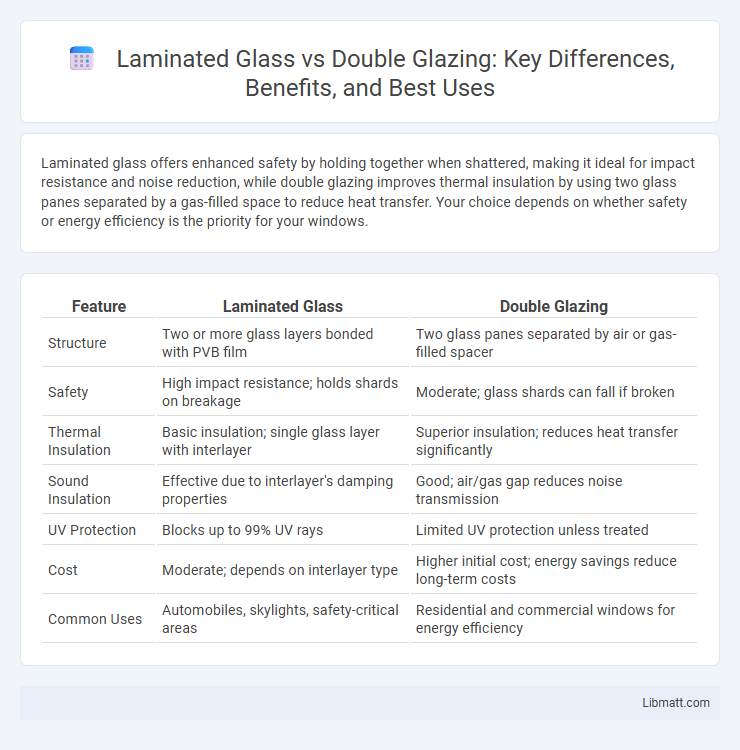Laminated glass offers enhanced safety by holding together when shattered, making it ideal for impact resistance and noise reduction, while double glazing improves thermal insulation by using two glass panes separated by a gas-filled space to reduce heat transfer. Your choice depends on whether safety or energy efficiency is the priority for your windows.
Table of Comparison
| Feature | Laminated Glass | Double Glazing |
|---|---|---|
| Structure | Two or more glass layers bonded with PVB film | Two glass panes separated by air or gas-filled spacer |
| Safety | High impact resistance; holds shards on breakage | Moderate; glass shards can fall if broken |
| Thermal Insulation | Basic insulation; single glass layer with interlayer | Superior insulation; reduces heat transfer significantly |
| Sound Insulation | Effective due to interlayer's damping properties | Good; air/gas gap reduces noise transmission |
| UV Protection | Blocks up to 99% UV rays | Limited UV protection unless treated |
| Cost | Moderate; depends on interlayer type | Higher initial cost; energy savings reduce long-term costs |
| Common Uses | Automobiles, skylights, safety-critical areas | Residential and commercial windows for energy efficiency |
Introduction to Laminated Glass and Double Glazing
Laminated glass consists of two or more layers of glass bonded with an interlayer, offering enhanced safety and sound insulation. Double glazing features two glass panes separated by a gas-filled space, providing superior thermal insulation and energy efficiency. Understanding these differences helps you choose the best option for your windows based on security, noise reduction, and heat retention needs.
Composition and Structure Differences
Laminated glass consists of two or more glass layers bonded with an interlayer, usually polyvinyl butyral (PVB), providing enhanced safety and sound insulation. Double glazing features two separate glass panes separated by a gas-filled gap, improving thermal insulation and energy efficiency. Your choice depends on whether you prioritize impact resistance and noise reduction (laminated) or better heat retention and condensation control (double glazing).
Thermal Insulation Performance
Laminated glass provides enhanced security and noise reduction but generally offers less thermal insulation compared to double glazing. Double glazing consists of two glass panes separated by an air or gas-filled gap, significantly reducing heat transfer and improving energy efficiency in your home. For optimal thermal insulation performance, double glazing is typically the superior choice, helping to maintain comfortable indoor temperatures and lower energy costs.
Soundproofing Capabilities
Laminated glass offers superior soundproofing capabilities by utilizing an interlayer that dampens sound vibrations, making it ideal for reducing noise pollution. Double glazing improves insulation by trapping air between two glass panes but is generally less effective at blocking low-frequency sounds compared to laminated glass. Your choice of glass can significantly impact noise reduction, especially in urban or high-traffic environments.
Safety and Security Features
Laminated glass enhances safety and security by incorporating a strong interlayer that holds shards together upon impact, reducing the risk of injury and intrusion. Double glazing improves security through its two panes of glass separated by a spacer, creating a robust barrier that is harder to break than single glass. While both options increase safety, laminated glass offers superior protection against forced entry and accidental breakage due to its resilience and impact resistance.
Energy Efficiency Comparison
Laminated glass provides enhanced security and sound insulation but offers moderate energy efficiency compared to double glazing, which significantly reduces heat transfer through its insulating air or gas-filled gap. Double glazing helps maintain a stable indoor temperature, lowering your heating and cooling costs by minimizing thermal loss. Choosing double glazing improves overall energy savings, making it more effective for energy-efficient window solutions.
Cost and Installation Considerations
Laminated glass typically costs less than double glazing but requires precise installation to ensure its safety features function correctly. Double glazing involves installing two glass panes separated by an air or gas layer, which can increase both material and labor costs due to its complexity. Your choice should consider not only upfront expenses but also installation requirements and long-term energy efficiency benefits.
Maintenance and Durability
Laminated glass offers superior durability with its interlayer that holds shards together upon impact, reducing the chance of breakage and the need for frequent replacement compared to double glazing. Double glazing requires regular inspection of seals to prevent condensation buildup and maintain energy efficiency, which can lead to maintenance costs over time. Choosing laminated glass can lower your maintenance needs while providing long-term resilience against damage.
Applications in Residential and Commercial Settings
Laminated glass, known for its enhanced security and sound insulation, is widely used in residential settings for windows, doors, and skylights to protect against break-ins and reduce noise pollution. Double glazing, featuring two glass panes with a gas-filled space in between, excels in energy efficiency by minimizing heat transfer, making it ideal for commercial buildings aiming to reduce heating and cooling costs. Your choice between laminated glass and double glazing depends on whether safety and acoustic control or thermal insulation is the primary requirement in your residential or commercial project.
Choosing the Right Option for Your Needs
Laminated glass offers enhanced safety and sound insulation through its interlayer, making it ideal for security and noise reduction. Double glazing provides superior thermal insulation by trapping air between two glass panes, perfect for energy efficiency and temperature control. Evaluating your priorities in security, noise, and energy savings will help you choose the right option for your needs.
laminated glass vs double glazing Infographic

 libmatt.com
libmatt.com